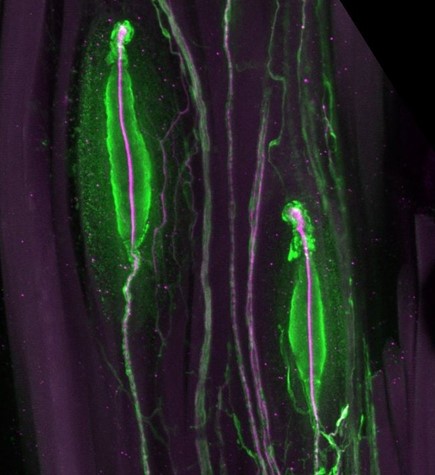By Josef Turecek
From walking on a sandy beach to laying on a soft pillow, we live in rich tactile environments. Each of these experiences involve a wide array of mechanical stimuli. Our nervous system has specialized sensory neurons, or mechanoreceptors, that have endings in our body and are tuned to different types of mechanical features. Unique combinations of these receptors are activated to provide a rich sense of touch.

Pacinian corpuscles: Two Pacinian neurons (magenta, Neurofilament) innvervating Pacinian corpuscles made of non-neuronal cells (green, S100) in the deep leg tissue of a mouse. Pacinian neurons are mechanosensory neurons found across mammals, from humans to mice, and detect small mechanical vibrations acting on our skin and body.
Touch has many features, including pressure, skin contact, and skin stretch. A less obvious component of touch is mechanical vibration. A familiar experience of mechanical vibration might be the feeling of a vibrating cell phone in your pocket, but mechanical vibrations occur during many tactile experiences. The nervous system has its own distinct vibration sensors that have endings deep in our skin. These vibration sensors, known as Pacinian neurons, have specialized endings in the skin known as Pacinian corpuscles. With their layered onion-like structure, Pacinian corpuscles are believed to allow these neurons to be uniquely tuned to small mechanical oscillations.
Although much is known about Pacinian neurons and how they respond to different mechanical vibration frequencies, it has been unclear how these neurons are activated during natural behaviors. Because sensory neurons are located outside the spinal cord, they are notoriously difficult to record electrical activity from, as any movement of the body will disrupt the recording. As a result, Pacinian neurons and other sensory neurons have only been studied in animals and humans that are completely still. But what happens when we encounter mechanical vibrations as we move around?
To answer this question, we developed methods to record from Pacinian neurons in awake freely moving mice. This allowed us to see how Pacinian neurons were activated as mice behaved naturally – for example as they were running, jumping, playing in sand, or exploring different materials.
We were first surprised by how active Pacinian neurons can be. Almost every behavior we examined involved mechanical vibrations that activated Pacinians. They could be exquisitely sensitive to overt vibrations in the environment. For example, when mice were placed on a tree branch, a Pacinian neuron could detect small taps to the opposite end of the branch many meters away. As the mouse stood on a platform, simply running my finger across the surface activated the mouse Pacinians as they detected the very small vibrations generated by my movement.
We were also surprised by how Pacinians could be activated during behaviors that seemingly did not involve vibration. For example, Pacinian neurons were activated by walking, and could be activated when the mouse moved its limbs in the air. As the mouse climbed a structure, Pacinians fired when the leg slipped on a sloped surface, the movement of the skin over the surface generating vibrations. Whether these vibration signals during motion are useful or important for guiding movements remains to be determined.
We also found that Pacinians can come in different varieties. Some Pacinians are extremely sensitive, detecting even the smallest tap to a table. Others are far less sensitive, or are tuned to different vibration frequencies. These less sensitive neurons are activated by jostling the ground, or when the mouse strongly strikes its leg as it walks. This variability in tuning could allow a wide range of stimuli to be detected and discriminated, for example from the subtle vibration of a distant train to the alarming rumble as it approaches.
Finally, we measured vibrations both inside and outside the lab. This allowed us to take stimuli and circumstances that we observed to activate Pacinians in the lab, and compare them to scenarios outside the lab. For example, we measured vibrations generated by a passing T train, which were certainly large enough to activate Pacinians. Other situations, such as the cracking of a tree branch, or of ice on a frozen pond, or humans walking on a wood floor, all generated large vibrations. Pacinians are well poised to detect these vibrations that could warn of imminent danger.
Pacinians are extraordinary sensors but are only the beginning of the somatosensory system. Although we were able to observe how Pacinians were activated during behavior, what the brain does with this information is poorly understood. Ongoing work aims to understand how vibration is integrated into our conscious perception of touch, and how vibration could help guide or inform our movements and behavior.
Josef Turecek is a postdoctoral fellow in the Ginty lab, in the Department of Neurobiology at Harvard Medical School.
Learn more in the original research article:
Coding of self and environment by Pacinian neurons in freely moving animals
Turecek J, Ginty DD. Neuron. 2024 Oct 9;112(19):3267-3277.e6. doi: 10.1016/j.neuron.2024.07.008. Epub 2024 Aug 7. PMID: 39116877; PMCID: PMC11466703.
News Types: Community Stories
